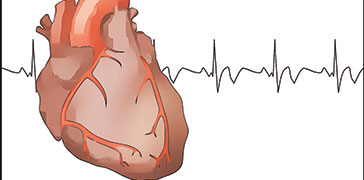US Pharm. 2023;48(2):15-16.

Irregular Heartbeat
All organs and tissues depend on proper heart function to deliver oxygen-rich blood to the rest of the body. An arrhythmia, a condition in which the electrical system of the heart is not working properly, is one reason that the heart may not perform this vital function. With arrhythmias, the heart beats too fast, too slowly, or irregularly. Arrhythmias such as ventricular tachycardia or ventricular fibrillation may be life-threatening. Chest pain or discomfort, dizziness, shortness of breath, weakness, lightheadedness, sweating, and fainting or near fainting are symptoms of these life-threatening arrhythmias, and they require immediate medical attention.
Another Disease Is Often the Cause
To better understand arrhythmia, it is important to know how the heart works. The heart is made up of four chambers: two atria (upper chambers) and two ventricles (lower chambers). A group of cells called the sinoatrial (SA) node is located at the top of the right atrium. The SA node is responsible for starting a heartbeat—it is the body’s natural pacemaker. During a heartbeat, an electrical signal spreads through the top of the heart, causing the atria to contract. The signal then spreads through the bottom of the heart, and the ventricles contract. For the heart to beat correctly, the flow of electricity through the heart must occur in this exact order. Under normal conditions, the human heart beats 60 to 100 times per minute. When the heart beats faster than normal, or more than 100 beats per minute (bpm), this condition is called tachycardia. When the heart beats fewer than 60 bpm, this condition is called bradycardia. Typically, regular rhythm is when the heart beats with about the same amount of time between each contraction. When the heart beats inconsistently between contractions, the rhythm is considered irregular.
Arrhythmias are common, affecting millions of people in the United States. Arrhythmias can occur in a healthy heart, but other conditions are often responsible. Common heart-related causes are hardening (narrowing) of the arteries, high blood pressure, errors in the electrical structure (“wiring”) of the heart, changes to the structure of the heart, and recovery after heart surgery. Non–heart-related causes are underactive or overactive thyroid, unbalanced sodium and potassium levels, stress or anxiety, certain medications, diabetes, sleep apnea (trouble breathing during sleep), COVID-19 infection, and genetics. Smoking, drug use, and alcohol may also lead to arrhythmias.
Treatment
Treatment options depend on whether there is tachycardia or bradycardia. The goals of therapy are to improve symptoms and to prevent life-threatening arrhythmias and sudden death. Stroke prevention is important in atrial fibrillation (AF) and atrial flutter. A cardiologist might prescribe medications that control the rate or rhythm of the heart. Beta-blockers (i.e., metoprolol, carvedilol) and calcium channel blockers (i.e., diltiazem) are classes of drugs used to keep the heart rate between 60 and 100 bpm. Sodium channel blockers (i.e., propafenone, flecainide) and potassium channel blockers (i.e., dofetilide, sotalol, amiodarone) are used to correct the rhythm of the heart. Patients may undergo a procedure called ablation, which uses radiofrequency to destroy a small number of heart cells to prevent them from triggering random heartbeats. In severe cases, a pacemaker or implantable cardioverter defibrillator may be used to monitor the heart’s electrical system and provide an automatic correction when arrhythmias occur.
Atrial Fibrillation Is the Most Common Arrhythmia
The most common type of arrhythmia is AF, in which the atria of the heart contract irregularly. The biggest complication associated with AF is stroke. If AF lasts long enough, the blood may begin to form a clot in the atrium. This clot can move out of the heart and into the brain. Doctors prescribe blood thinners or anticoagulants for people with AF at high risk for stroke. Anticoagulants prevent the clot from forming and lower the risk of stroke. The most common anticoagulants on the market are Coumadin (warfarin), Pradaxa (dabigatran), Xarelto (rivaroxaban), Eliquis (apixaban), and Savaysa (edoxaban).
The content contained in this article is for informational purposes only. The content is not intended to be a substitute for professional advice. Reliance on any information provided in this article is solely at your own risk.
To comment on this article, contact rdavidson@uspharmacist.com.





